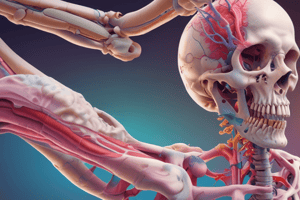Podcast
Questions and Answers
What is a characteristic feature of osteomyelitis that helps in its differentiation from malignancy?
What is a characteristic feature of osteomyelitis that helps in its differentiation from malignancy?
- Presence of multiple bone involvement
- Formation of sequestration (correct)
- Patient's age typically above 40 years
- Ill-defined margins of the lesion
How does bone involvement in osteomyelitis differ from that in Paget disease?
How does bone involvement in osteomyelitis differ from that in Paget disease?
- Multiple bones are involved in osteomyelitis
- Single bone is involved in osteomyelitis (correct)
- Multiple bones are involved in Paget disease
- Single bone is involved in Paget disease
What is a key difference in the age of patients with osteomyelitis and malignancy?
What is a key difference in the age of patients with osteomyelitis and malignancy?
- Both osteomyelitis and malignancy typically occur in patients below 40 years
- Both osteomyelitis and malignancy typically occur in patients above 40 years
- Osteomyelitis typically occurs in patients above 40 years, while malignancy occurs in patients below 40 years
- Osteomyelitis typically occurs in patients below 40 years, while malignancy occurs in patients above 40 years (correct)
How do the margins of eosinophilic granuloma differ from those of osteomyelitis?
How do the margins of eosinophilic granuloma differ from those of osteomyelitis?
What is the main purpose of differentiating osteomyelitis from other conditions?
What is the main purpose of differentiating osteomyelitis from other conditions?
What is the primary reason radiography is useful for detecting dental caries?
What is the primary reason radiography is useful for detecting dental caries?
What is the primary method for diagnosing carious lesions?
What is the primary method for diagnosing carious lesions?
What type of carious lesion is nearly impossible to identify clinically?
What type of carious lesion is nearly impossible to identify clinically?
What is the characteristic of an early carious lesion?
What is the characteristic of an early carious lesion?
What is the significance of cavitation in proximal surfaces of teeth?
What is the significance of cavitation in proximal surfaces of teeth?
What percentage of proximal surface lesions cannot be seen clinically and may be detected only with radiographs?
What percentage of proximal surface lesions cannot be seen clinically and may be detected only with radiographs?
What is the minimum demineralization required for radiographic detection of a proximal carious lesion?
What is the minimum demineralization required for radiographic detection of a proximal carious lesion?
What is the term used to describe rapid progression with severe and widespread root surface caries?
What is the term used to describe rapid progression with severe and widespread root surface caries?
What is the most common location for interproximal carious lesions?
What is the most common location for interproximal carious lesions?
What is the prevalence of root surface caries in an aged population?
What is the prevalence of root surface caries in an aged population?
Study Notes
Differential Diagnosis of Osteomyelitis
- Osteomyelitis must be differentiated from malignancy, Paget disease, and eosinophilic granuloma
- Malignancy lacks sequestration, a typical feature of osteomyelitis
- Patients with osteomyelitis are typically under 40 years old, while those with malignancy are usually over 40
Comparison with Paget Disease
- Paget disease involves multiple bones, whereas osteomyelitis typically affects a single bone
Comparison with Eosinophilic Granuloma
- Eosinophilic granuloma has better-defined margins compared to osteomyelitis
Studying That Suits You
Use AI to generate personalized quizzes and flashcards to suit your learning preferences.
Description
Learn to differentiate osteomyelitis from malignancy, Paget disease, and eosinophilic granuloma. Understand the key features and characteristics of each condition to make an accurate diagnosis.




